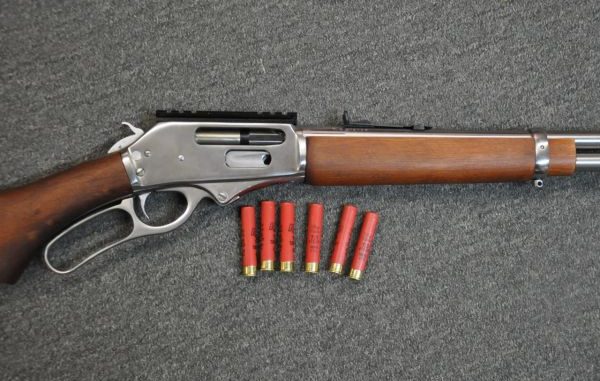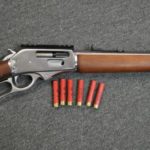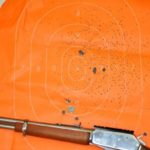
Rossi’s RG410 Lever-Action
An attorney friend who knows a little more about guns than I do about the dark side of the moon — but not much more — was wandering around a regional gun show, looking for I’m not sure what.
I think he had been caught up in all the furor and hype and just figured he needed another gun to go with his one revolver.
He called me excitedly after the show, wanting to go to the range and shoot his newest acquisition. He had spotted and fallen in love with the new Rossi Rio Grande Lever Action .410 shotgun — the stainless steel version.
Ostensibly he bought it for his stepson, but I’m not so sure.
If you aren’t familiar with this nice-looking oddity, Rossi figured out how to make a .410 shotgun in lever action that looks like the ubiquitous .30-30 deer rifles that have been a part of the lore of the deer camp since the early part of the last century. My personal choice was always the Marlin style, which featured side ejection, thus allowing a top-mounted scope.
The original Winchester design, from the 1890s, ejected the spent shells through a top ejection port, eliminating the possibility of a telescopic sight — unless you side-mounted the scope, a weird arrangement I have seen in ads but never on a real, shooting firearm.
Rossi, which is now a division of Taurus, uses a side-ejection system and supplies the buyer with a pre-mounted Weaver-style scope mount.
Intrigued by the idea of a shotgun that worked like a lever-action deer rifle, I agreed to meet him at the range to shoot and pattern the gun.
I had done some research when we met, and discovered a litany of complaints about the gun jamming frequently — with failures to feed and eject.
I also noted that, in all the literature I dug up on the Internet from Rossi, nowhere did it mention that the gun shoots 2 1/2-inch shells — not the larger, standard 3-inch shells utilized by most hunters.
I strongly suspect the complaints on the gun online were because people were trying to shoot 3-inch shells in them. One owner even pointed out he quit having problems once he switched to 2 1/2-inch shells.
My friend showed up with his new gun, and it was a handsome piece. To look at it, you would think you were looking at a Marlin copy — and it was not readily apparent the gun fired shotgun shells.
Designated the RG410SS (the blued version is the RG410B), the gun has a Brazilian hardwood stock with a recoil pad and spacer.
It also has an adjustable buckhorn sight, a side-loading gate, a tubular magazine with a six-plus-one capacity, a hammer extension and a cross-bolt safety.
Not really knowing what to expect (according to the literature, Rossi chokes the gun with a modified choke) we set up to shoot at 15 yards — a considerably shorter distance than the normal 30 yards at which you pattern a shotgun.
We also patterned the gun on B-27 targets — the standard man-sized silhouettes used by law enforcement the world over.
My buddy had brought about a box of shells, mixed between birdshot and buckshot. We started firing at the hanging targets, and I was impressed.
First off, at that range the buckshot threw really nice patterns that were about half the size of a standard paper plate. No slouch here: You could also shoot slugs in this gun and, mixed with buckshot, have a heck of a neat deer gun for a youngster.
Remember also that these are 000 buckshot — larger than the 00 diameter of .33. This buckshot is about .36 caliber.
While I didn’t do the standard pellet count to determine pattern density, the photos show that at 15 yards nothing is going to fly through holes in the pattern — it was uniform and dense.
The acid test, of course, was reliability. As I suspected, it wasn’t an issue.
We had one failure to feed when the round did not slip backward into the breech to be lifted and pushed into the chamber. We had to push it forward past the loading gate and compress the loading gate to allow it to slip out of the magazine. We couldn’t find anything wrong with the shell, and it worked fine after re-inserting it.
I still suspect most of the problems listed by the new owners could be traced back to using 3-inch shells. We ran through some 25 shells, with only the one failure to feed. And we shot several strings where we worked the lever action as fast as we could, resulting in very satisfying, completely destroyed targets.
My overall impressions of the gun were good. It is a handsome piece, and the fit and finish are quite good. While I consider it more of a plaything, it could also be considered for Cowboy Action Shooting if the rules allow it.
One cautionary note: If you are taking this gun on the skeet range, no problem, but if you plan on giving it to your kid as a youth model hunting shotgun, be sure and check the game laws in your state. All states adhere to federal law and require a plug in the magazine of any shotgun used to hunt migratory fowl.
Some states simply say every shotgun used for hunting ANY game must have a plug in it limiting capacity to two shells in the magazine and one in the chamber.
Having a shotgun that looks like a lever-action rifle will not impress a game warden who checks and finds it will hold seven rounds — an embarrassing, expensive and a poor example to set for your budding hunting companion.




